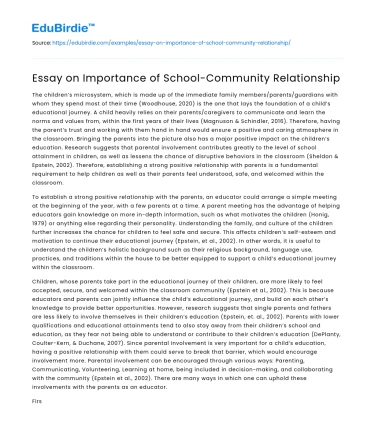The children’s microsystem, which is made up of the immediate family members/parents/guardians with whom they spend most of their time (Woodhouse, 2020) is the one that lays the foundation of a child’s educational journey. A child heavily relies on their parents/caregivers to communicate and learn the norms and values from, within the first years of their lives (Magnuson & Schindler, 2016). Therefore, having the parent’s trust and working with them hand in hand would ensure a positive and caring atmosphere in the classroom. Bringing the parents into the picture also has a major positive impact on the children’s education. Research suggests that parental involvement contributes greatly to the level of school attainment in children, as well as lessens the chance of disruptive behaviors in the classroom (Sheldon & Epstein, 2002). Therefore, establishing a strong positive relationship with parents is a fundamental requirement to help children as well as their parents feel understood, safe, and welcomed within the classroom.
To establish a strong positive relationship with the parents, an educator could arrange a simple meeting at the beginning of the year, with a few parents at a time. A parent meeting has the advantage of helping educators gain knowledge on more in-depth information, such as what motivates the children (Honig, 1979) or anything else regarding their personality. Understanding the family, and culture of the children further increases the chance for children to feel safe and secure. This affects children’s self-esteem and motivation to continue their educational journey (Epstein, et al., 2002). In other words, it is useful to understand the children’s holistic background such as their religious background, language use, practices, and traditions within the house to be better equipped to support a child’s educational journey within the classroom.
Save your time!
We can take care of your essay
- Proper editing and formatting
- Free revision, title page, and bibliography
- Flexible prices and money-back guarantee
Children, whose parents take part in the educational journey of their children, are more likely to feel accepted, secure, and welcomed within the classroom community (Epstein et al., 2002). This is because educators and parents can jointly influence the child’s educational journey, and build on each other’s knowledge to provide better opportunities. However, research suggests that single parents and fathers are less likely to involve themselves in their children’s education (Epstein, et. al., 2002). Parents with lower qualifications and educational attainments tend to also stay away from their children’s school and education, as they fear not being able to understand or contribute to their children’s education (DePlanty, Coulter-Kern, & Duchane, 2007). Since parental involvement is very important for a child’s education, having a positive relationship with them could serve to break that barrier, which would encourage involvement more. Parental involvement can be encouraged through various ways: Parenting, Communicating, Volunteering, Learning at home, being included in decision-making, and collaborating with the community (Epstein et al., 2002). There are many ways in which one can uphold these involvements with the parents as an educator.
First of all, regular or day-to-day communication through notes or class platforms would be a means of keeping parents in the loop of what is happening in the class. This would also serve as a means for educators to gain information on what the children are currently going through at home, which might better explain behaviors in school. Another means of keeping in touch with parents would be face-to-face interaction. This could be done before/after school or during parent’s days.
Parents can forward the concerns, goals, and needs of the children. Through volunteering, they can help and become part of the school community, and contribute to money collections and school activities. Parents can also take on the role of educating the children at home, or lend a helping hand in the classroom itself, which reduces the workload of educators. Another means of how to include parents is taking into consideration their whole life. For example, in this classroom, some quite several parents work in the area of construction work. These funds of knowledge could be implemented into activities and themes. They could give their contribution to the classroom by providing information, tools, and opportunities for the children as guest speakers. With the topic of construction, one could also include multiple parents, to see the different aspects of what it means to build a house, starting from the stone till the tiles are laid. There are children in the class who have mothers who are housewives. Even though they might not have an occupation at this point, their knowledge and talents in other areas of life can also be used as a resource to contribute to the classroom. These could include helping with resources by knitting or crafting, story-telling, or accompanying the children during outings to provide a helping hand.






 Stuck on your essay?
Stuck on your essay?

